Imagination Announces B-Series GPU IP: Scaling up with Multi-GPU
by Andrei Frumusanu on October 13, 2020 4:00 AM EST- Posted in
- GPUs
- Imagination Technologies
- SoCs
- IP
Configurations - Up to 4 GPUs at 6TFLOPs
Starting off with the smallest GPU building blocks, it’s good to remind ourselves how an Imagination GPU looks like – the following is from last year’s A-Series presentation:
| PowerVR GPU Comparison | ||||
| AXT-16-512 BXT-16-512 |
GT9524 | GT8525 | GT7200 Plus | |
| Core Configuration |
1 SPU (Shader Processing Unit) - "GPU Core" 2 USCs (Unified Shading Clusters) - ALU Clusters |
|||
| FP32 FLOPS/Clock MADD = 2 FLOPs MUL = 1 FLOP |
512 (2x (128x MADD)) |
240 (2x (40x MADD+MUL)) |
192 (2x (32x MADD+MUL)) |
128 (2x (16x MADD+MADD)) |
| FP16 Ratio | 2:1 (Vec2) | |||
| Pixels / Clock | 8 | 4 | ||
| Texels / Clock | 16 | 8 | 4 | |
| Architecture | A-Series B-Series |
Series-9XTP (Furian) |
Series-8XT (Furian) |
Series-7XT (Rogue) |
Fundamentally and at a high-level, the new B-Series GPU microarchitecture looks very similar to the A-Series. Microarchitecturally, Imagination noted that we should generally expect a 15% increase in performance or increase in efficiency compared to the A-Series, with the building blocks of the two GPU families being generally the same save for some more important additions such as the new IMGIC (Imagination Image Compression) implementation which we’ll cover in a bit.
An XT GPU still consists of the new SPU design which houses the new more powerful TPU (Texture Processing Unit) as well as the new 128-wide ALU designs that is scaled into ALU clusters called USCs (Unified Shading Clusters).
Imagination’s current highest-end hardware implementation in the BXT series is the BXT 32-1024, and putting four of these together creates an MC4 GPU. In a high-performance implementation reaching up to 1.5GHz clock speeds, this configuration would offer up to 6TFLOPs of FP32 computing power. Whilst this isn’t quite enough to catch up to Nvidia and AMD, it’s a major leap for a third-party GPU IP provider that’s been mostly active in the mobile space for the last 15 years.
The company’s BXM series continues to see a differentiation in the architecture as some of its implementations do not use the ultra-wide ALU design of the XT series. For example, while the BXM-8-256 uses one 128-wide USC, the more area efficient BXM 4-64 for example continues to use the 32-wide ALU from the 8XT series. Putting four BXM-4-64 GPUs together gets you to a higher performance tier with a better area and power efficiency compared to a larger single GPU implementation.
The most interesting aspect of the multi-GPU approach is found in the BXE series, which is Imagination’s smallest GPU IP that purely focuses on getting to the best possible area efficiency. Whilst the BXT and BXM series GPUs until now are delivered as “primary” cores, the BXE is being offered in the form of both a primary as well as a secondary GPU implementation. The differences here is that the secondary variant of the IP lacks a firmware processor as well as a geometry processing, instead fully relying on the primary GPU’s geometry throughput. Imagination says that this configuration would be able to offer quite high compute and fillrate capabilities in extremely minuscule area usage.
| PowerVR Hardware Designs GPU Comparison | ||||||
| Family | Texels/ Clock |
FP32/ Clock |
Cores | USCs | Wavefront Width |
MC Design |
| BXT-32-1024 MC1 | 32 | 1024 | 1 | 4 | 128 | P |
| BXT-16-512 MC1 | 16 | 512 | 1 | 2 | 128 | P |
| BXM-8-256 MC1 | 8 | 256 | 1 | 1 | 128 | P |
| BXM-4-64 MC1 | 4 | 64 | 1 | 1 | 32 | P |
| BXE-4-32 Secondary | 4 | 32 | 1 | 1 | 16 | S |
| BXE-4-32 MC1 | 4 | 32 | 1 | 1 | 16 | P |
| BXE-2-32 MC1 | 2 | 32 | 1 | 1 | 16 | P |
| BXE-1-16 MC1 | 1 | 16 | 1 | 1 | 8 | P |
Putting the different designs into a table, we’re seeing only 8 different hardware designs that Imagination has to create the RTL and do physical design and timing closure on. This is already quite a nice line-up in terms of scaling from the lowest-end area focused IP to something that would be used in a premium high-end mobile SoC.
| PowerVR MC GPU Configurations | ||||||
| Family | Texels/ Clock |
FP32/ Clock |
Cores | USCs | Wavefront Width |
MC Design |
| BXT-32-1024 MC4 | 128 | 4096 | 4 | 16 | 128 | PPPP |
| BXT-32-1024 MC3 | 96 | 3072 | 3 | 12 | 128 | PPP |
| BXT-32-1024 MC2 | 64 | 2048 | 2 | 8 | 128 | PP |
| BXT-32-1024 MC1 | 32 | 1024 | 1 | 4 | 128 | P |
| BXT-16-512 MC1 | 16 | 512 | 1 | 2 | 128 | P |
| BXM-8-256 MC1 | 8 | 256 | 1 | 1 | 128 | P |
| BXM-4-64 MC4 | 16 | 256 | 4 | 4 | 32 | PPPP |
| BXM-4-64 MC3 | 12 | 192 | 3 | 3 | 32 | PPP |
| BXM-4-64 MC2 | 8 | 128 | 2 | 2 | 32 | PP |
| BXM-4-64 MC1 | 4 | 64 | 1 | 1 | 32 | P |
| BXE-4-32 MC4 | 16 | 128 | 4 | 4 | 16 | PSSS |
| BXE-4-32 MC3 | 12 | 96 | 3 | 3 | 16 | PSS |
| BXE-4-32 MC2 | 8 | 64 | 2 | 2 | 16 | PS |
| BXE-4-32 MC1 | 4 | 32 | 1 | 1 | 16 | P |
| BXE-2-32 MC1 | 2 | 32 | 1 | 1 | 16 | P |
| BXE-1-16 MC1 | 1 | 16 | 1 | 1 | 8 | P |
The big flexibility gain for Imagination and their customers is that they can simple take one of the aforementioned hardware designs, and scale these up seamlessly by laying out multiple GPUs. On the low-end, this creates some very interesting overlaps in terms of compute abilities, but offer different fillrate capabilities at different area efficiency options.
At the high-end, the biggest advantage is that Imagination can quadruple their processing power from their biggest GPU configuration. Imagination notes that for the BXT series, they no longer created a single design larger than the BXT-32-1024 because the return on investment would simply be smaller, and involve more complex timing work than if a customer would simply scale performance up via a multi-core implementation.


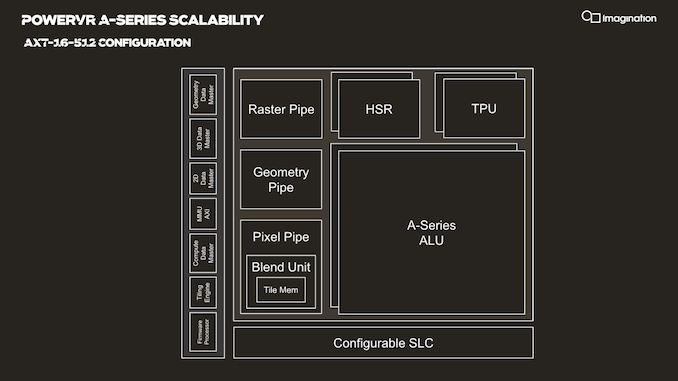
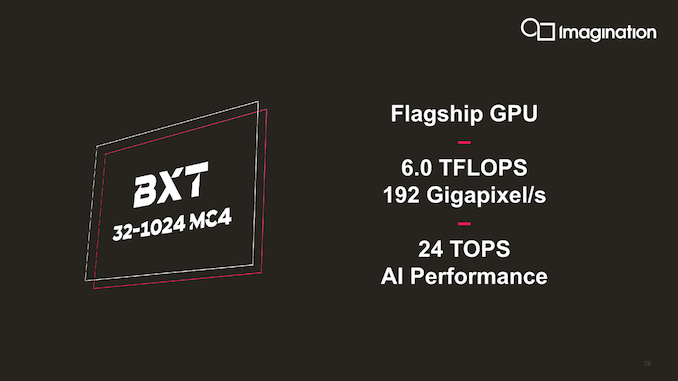
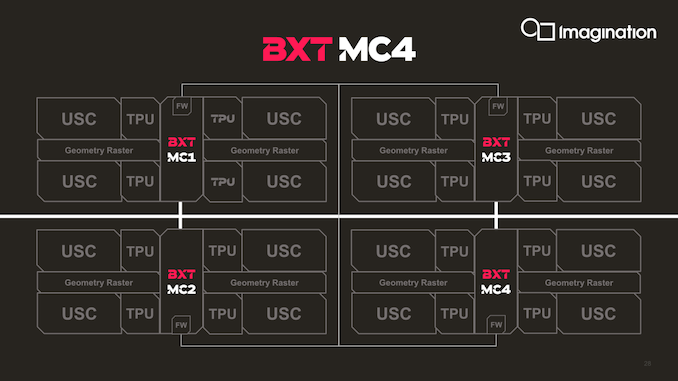
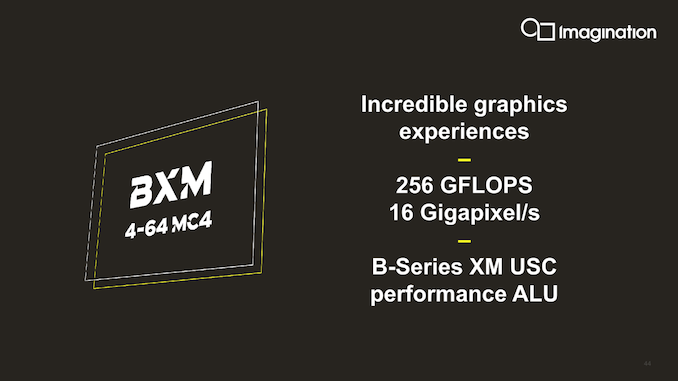
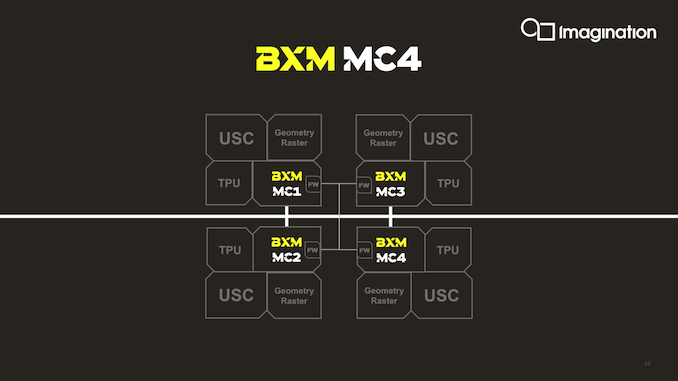
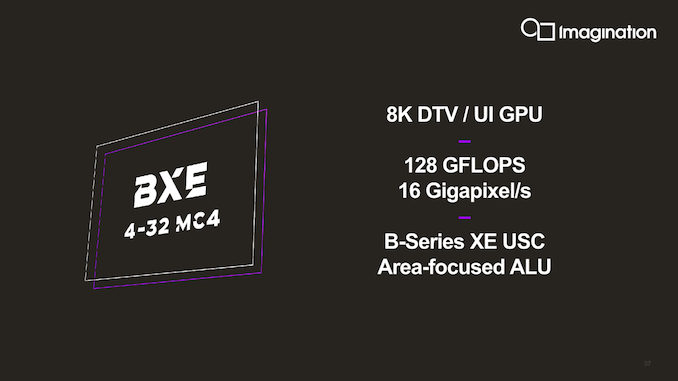
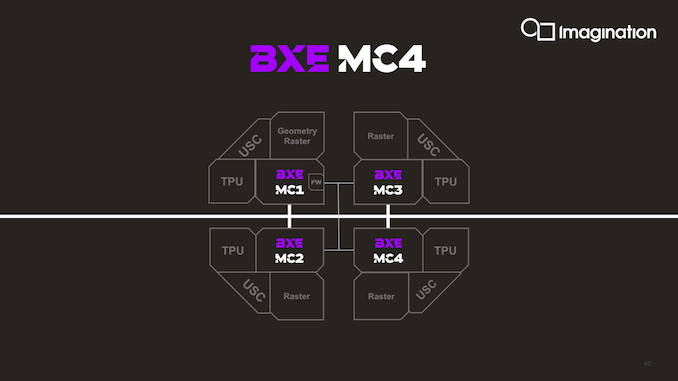








74 Comments
View All Comments
Threska - Wednesday, October 14, 2020 - link
"The MGPU seems like it will be the future of gpu computing, but right now putting multiple slabs of silicon together and efficiently connecting them is expensive and power hungry which is undesirable."https://www.digitaltrends.com/computing/google-sta...
lightningz71 - Tuesday, October 13, 2020 - link
Judging by their past performance with respect to drivers for windows platform systems, I wouldn't touch their desktop products with a ten foot pole until they have thoroughly demonstrated a willingness to:Provide a set of fully functioning drivers
Provide regular updates to those drivers to address bugs and odd behavior
Provide at the absolute least some framework for FOS drivers to be built for Linux
Provide a driver whad for standard linux desktops
Continue to provide these things for a period of several years
Because, up until now, they've done none of the above. Their last desktop product was an integrated gpu for Intel on an early Atom product. They, and Intel, promptly abandoned the product within months of releasing it, and never provided a single functional driver for the very next edition of Windows that was released within six months of the release of that processor. The drivers that were released for the existing windows version had rather basic functionality, were still buggy, and offered no useful video acceleration for any (at the time) modern video compression protocol.
So, they can release it all they want to, but I'm certainly not going near it for a long time.
29a - Tuesday, October 13, 2020 - link
They have tried before but they didn't do very well. I remember this card having a lot of hype before it was released.https://www.anandtech.com/show/735
myownfriend - Tuesday, October 13, 2020 - link
And a lot of people still talk about that card. That was one hell of a review.Threska - Wednesday, October 14, 2020 - link
Had the previous, and yes they were for the time period.Alexvrb - Wednesday, October 14, 2020 - link
The Kyros were great cards for their day, affordable and powerful.Lindegren - Wednesday, October 14, 2020 - link
They did, in 2001 - https://www.anandtech.com/show/735... but they focused on mobile instead, and that is why they are still here, unlike 3dfx and s3
Kel Ghu - Wednesday, October 14, 2020 - link
Imagination Tech's PowerVR tech started on PC. They left the market because their cards were not powerful enough and refocused on the mobile market, where their tech was more power-efficient. It's funny now to hear people asking them to come back to PC. And I'm all for it!myownfriend - Thursday, October 15, 2020 - link
That's not why they left. Imagination doesn't work like Nvidia or AMD. They don't make chips that others buy and place on boards for sale. Imagination makes source code for GPUs and in order for someone to make a graphics card out of it, someone needs to first license that code and make a physical chip.Nobody made a successor to the chip used in the Kyro II so nobody was able to release cards that used anything new after that.
In Anandtech's own article for the Kyro II it shows it outperforming cards that are twice the cost, use the twice the power, and have three times the fill-rate. It's limitation was that it didn't have a hardware T&L unit at the time but the next design would have.
EthiaW - Tuesday, October 13, 2020 - link
Why is the company still making futile investment to large GPUs such as BXT-16/32 without any forseeable customers? Just confused.